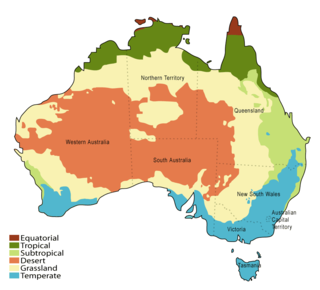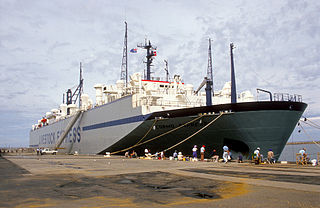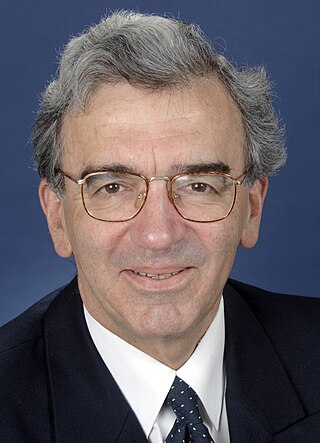
Although Australia is mostly arid, the nation is a major agricultural producer and exporter, with over 325,300 employed in agriculture, forestry and fishing as of February 2015. Agriculture and its closely related sectors earn $155 billion-a-year for a 12% share of GDP. Farmers and grazers own 135,997 farms, covering 61% of Australia's landmass. Across the country there is a mix of irrigation and dry-land farming. The success of Australia to become a major agricultural power despite the odds is facilitated by its policies of long-term visions and promotion of agricultural reforms that greatly increased the country's agricultural industry.
Compassion in World Farming (CIWF) is a campaigning and lobbying animal welfare organisation. It campaigns against the live export of animals, certain methods of livestock slaughter, and all systems of factory farming. It has received celebrity endorsements and been recognized by BBC Radio 4 for its campaigning. It has grown to a global movement with partners and supporters concerned about the welfare of farm animals.

Live export is the commercial transport of livestock across national borders. The trade involves a number of countries with the Australian live export industry being one of the largest exporters in the global trade. According to the Australian Bureau of Statistics, exports of live sheep rose 21.4% and live calves increased 9.7% between March 2017 and March 2018. During 2017 alone, Australia exported 2.85 million living animals in shipping containers and airplanes. The expansion of the trade has been supported by the introduction of purpose-built ships which carry large numbers of animals. The amount of livestock exported from the European Union grew to nearly 586m kilograms between 2014 and 2017, a 62.5% increase during the time period.

Joseph William Ludwig is an Australian barrister and retired politician. He was a member of the Australian Senate for the state of Queensland from July 1999 to May 2016, representing the Australian Labor Party. Ludwig served in a range of portfolios in the first Rudd and the second Gillard ministries until his resignation from Cabinet as the Minister for Agriculture, Fisheries and Forestry and Minister Assisting the Attorney-General on Queensland Floods Recovery, in 2013.

Pastoral farming is aimed at producing livestock, rather than growing crops. Examples include dairy farming, raising beef cattle, and raising sheep for wool. In contrast, arable farming concentrates on crops rather than livestock. Finally, mixed farming incorporates livestock and crops on a single farm. Some mixed farmers grow crops purely as fodder for their livestock; some crop farmers grow fodder and sell it. In some cases pastoral farmers are known as graziers, and in some cases pastoralists. Pastoral farming is a non-nomadic form of pastoralism in which the livestock farmer has some form of ownership of the land used, giving the farmer more economic incentive to improve the land. Unlike other pastoral systems, pastoral farmers are sedentary and do not change locations in search of fresh resources. Rather, pastoral farmers adjust their pastures to fit the needs of their animals. Improvements include drainage, stock tanks, irrigation and sowing clover.

Livestock transportation is the movement of livestock, by road, rail, ship, or air. Livestock are transported for many reasons, including slaughter, auction, breeding, livestock shows, rodeos, fairs, and grazing. When the movement crosses borders into another country, it is known as live export.

Australia and Indonesia have established diplomatic relations since 1949, when Australia recognised Indonesia's independence. Historically, contact between Australians and Indonesians began as early as the 16th century prior to the arrival of the Europeans, through Makassan interactions with indigenous Australians on Australia's western and northern coasts.

A livestock carrier is a large ship used in the live export of sheep, cattle and goats. They are specially built new or converted from container ships.

Bovine spongiform encephalopathy (BSE), commonly known as mad cow disease, is an incurable and invariably fatal neurodegenerative disease of cattle. Symptoms include abnormal behavior, trouble walking, and weight loss. Later in the course of the disease the cow becomes unable to function normally. There is conflicting information about the time between infection and onset of symptoms. In 2002, the World Health Organization (WHO) suggested it to be approximately four to five years. Time from onset of symptoms to death is generally weeks to months. Spread to humans is believed to result in variant Creutzfeldt–Jakob disease (vCJD). As of 2018, a total of 231 cases of vCJD had been reported globally.

In New Zealand, agriculture is the largest sector of the tradable economy. The country exported NZ$46.4 billion worth of agricultural products in the 12 months to June 2019, 79.6% of the country's total exported goods. The agriculture, forestry and fisheries sector directly contributed $12.653 billion of the national GDP in the 12 months to September 2020, and employed 143,000 people, 5.9% of New Zealand's workforce, as of the 2018 census.

Agriculture in the United Kingdom uses 69% of the country's land area, employs 1% of its workforce and contributes 0.5% of its gross value added. The UK currently produces about 60% of its domestic food consumption.

The history of the domestic sheep goes back to between 11,000 and 9,000 BC, and the domestication of the wild mouflon in ancient Mesopotamia. Sheep are among the first animals to have been domesticated by humans. These sheep were primarily raised for meat, milk, and skins. Woolly sheep began to be developed around 6000 BC. They were then imported to Africa and Europe via trading.

The Battle of Brightlingsea refers to a series of protests by animal rights supporters held in Brightlingsea, England, between 16 January and 30 October 1995, to prevent the export of livestock through the town. During this time period, early 1990s, this action had been talked and argued about among individuals. The name was first used by the media in The Independent newspaper, after Essex Police used riot control measures against demonstrators.

Animals Australia is an Australian animal protection organisation. Its aim is to investigate and expose animal cruelty, inspire kindness to animals through public awareness campaigns—particularly focused on farmed animals—and provide funding and support to other animal organisations where appropriate, for example in emergency response during the 2019/2020 Australian Black Summer bushfires and COVID-19 pandemic.

Animal welfare in New Zealand is governed by the Animal Welfare Act 1999 and a number of organisations actively advocate for both animal welfare and animal rights. Pest control and farming practices have been scrutinised with respect to animal welfare issues. The legality of killing dogs and cats for consumption has also been criticized.

William John Farmer is a retired senior Australian public servant and policymaker, best known for his time as Secretary of the Department of Immigration and Multicultural Affairs and for his career in the Australian diplomatic service.

Agriculture in Wales has in the past been a major part of the economy of Wales, a largely rural country that forms part of the United Kingdom. Wales is mountainous and has a mild, wet climate. This results in only a small proportion of the land area being suitable for arable cropping, but grass for the grazing of livestock is present in abundance. As a proportion of the national economy, the importance of agriculture has become much reduced; a high proportion of the population now live in the towns and cities in the south of the country and tourism has become an important form of income in the countryside and on the coast. Arable cropping is limited to the flatter parts and elsewhere dairying and livestock farming predominate.

This article is about the treatment of and laws concerning non-human animals in Australia. Australia has moderate animal protections by international standards.

The United Kingdom was afflicted with an outbreak of Bovine spongiform encephalopathy, and its human equivalent variant Creutzfeldt–Jakob disease (vCJD), in the 1980s and 1990s. Over four million head of cattle were slaughtered in an effort to contain the outbreak, and 178 people died after contracting vCJD through eating infected beef. A political and public health crisis resulted, and British beef was banned from export to numerous countries around the world, with some bans remaining in place until as late as 2019.





















